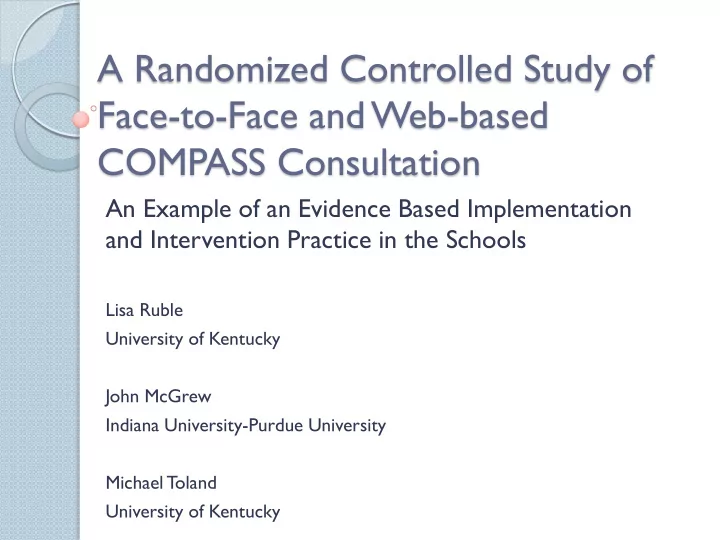

A Randomized Controlled Study of Face-to-Face and Web-based COMPASS Consultation An Example of an Evidence Based Implementation and Intervention Practice in the Schools Lisa Ruble University of Kentucky John McGrew Indiana University-Purdue University Michael T oland University of Kentucky
Why Schools? Only public funded service provider for children with disabilities ◦ May be the sole provider for children of low income, minority, or less educated mothers More than 500% increase in students served High burnout…. National shortage teachers Three times higher costs for education Less than 10% of research supported practices used in classrooms __________________________________ Hess et al., 2008; Morrier, et al., 2011; Ruble, et al., 2010; Simpson et al., 2011; Stahmer et al., 2005
Implementation Science The processes and procedures that help or hinder the transfer, adoption, and use of evidence-based practices. Implementation Intervention Practice practice practice outcome _________________________________________________________ Dunst (2012). Framework for Conceptualizing the Relationship Between Evidence-Based Implementation and Intervention Practices. http://www.puckett.org/ Kelly, B., & Perkins, D.F., (Eds.). (2012). Handbook of implementation science for psychology in education . Cambridge, England: Cambridge University Press.
Evidence Based Interventions “Focused treatments” National Professional Development Center ◦ http://autismpdc.fpg.unc.edu/ OCALI – Autism Modules ◦ http://www.autisminternetmodules.org/ National Autism Center ◦ http://www.nationalautismcenter.org/
Consultation Consultation is effective and has a “multiplier effect” ◦ By supporting teachers, we support an even larger number of students ____________________________________ Busse et al., 1995; Medway & Updyke, 1985; Sheridan et al., 1996
Consultation As implementation & intervention practice ◦ Quality of the procedures as delivered by the implementation agent (Consultant) ◦ Quality of the strategies as delivered by the intervention agent (T eacher) Implementation Practice Intervention Practice Practice Outcome COMPASS Instructional Quality Child Goal Attainment
Overview of COMPASS (Collaborative Model for Promoting Competence and Success) Decision-making framework Based on assumptions of child- environment interaction as critical Proactive problem solving Research-supported practices Teaching plan is specific to autism Forms are specific to autism Teaching strategies are linked to each specific skill __________________________ Ruble, Dalrymple, & McGrew, 2012
Research Questions Can we replicate findings from a previous RCT of COMPASS and TAU ( d = 1.5) Does COMPASS work as well when delivered via Web based technologies? ◦ Child goal attainment outcome ◦ Fidelity of intervention practice ◦ Teacher satisfaction ______________________________ Ruble, Dalrymple, & McGrew, 2010 NIMH RC1MH089760
Design Teachers randomized to TAU+, FF, or WEB group (N=44) TX: FF COMPASS consultation at start of school year (parents and teachers) Half received 4 FF Half received 4 WEB coaching sessions (n = 14) coaching sessions (n = 15) FF = face-to-face; WEB = web-based
Group Comparison TAU Group Intervention Groups ◦ Assessment of baseline • 3 hour consultation skills (parent & teacher) ◦ Services as usual 3 IEP objectives ◦ + Online training Measurable Teaching plans • Goal attainment scales • 4 teacher coaching sessions (FF or WEB) (1 - 1.5 / 4-6 weeks) ◦ Final evaluation ◦ Final evaluation
WEB Group: T eacher Equipment
Adobe Connect Session
Time 1 Comparisons TAU FF WEB Variable M SD M SD M SD p ADOS (S&C) 17.9 3.7 17.4 4.2 19.4 2.5 .29 DAS 61.3 24.6 62.4 17.6 45.5 20.4 .06 OWLS 53.9 14.2 58.4 15.2 48.9 8.2 .15 Vineland (TR) 58.2 14.8 64.7 12.5 56.6 13.6 .28 Child Age 5.6 1.5 6.1 1.4 5.55 1.7 .61 Years teaching 1.1 2.1 0.1 0.3 1.9 3.5 .30 Students 3.3 4.3 8.9 8.0 6.7 7.3 .11 taught Services 1.4 1.3 0.7 0.8 1.8 1.5 .15 received Hours of 13.2 23.2 4.9 7.5 5.7 6.4 .38 services
Conceptual Framework Implementation Practice Intervention Practice Practice Outcome COMPASS Instructional Quality Child Goal Attainment
Practice Outcome GAS Change 10 8 6 4 2 0 TAU WEB FF Planned Comparisons WEB FF TAU d = .81 d = 1.49 WEB ns
Implementation and Intervention Practice Fidelity Implementation Practice Fidelity – What the Consultant Did Initial Consult: 80-90% of features implemented Coaching: 3.8 / 4.0 No diff FF and WEB Intervention Practice Fidelity (T eacher Adherence) by Coaching Session Group 1 2 3 4 FF 3.6 3.4 4.0 4.2 WEB 3.7 3.7 4.1 4.2 1 1-5 Likert Scale 1 ‘0%’; 5 ‘100%’ No diff FF and WEB. Significant difference in adherence ratings across coaching sessions, 2 (3) = 12.39, p = .006, Kendall’s W = .15
Satisfaction Median = 3.7 / 4 Initial Consult: ◦ No difference between FF and WEB groups for teachers, z = -0.07, p = .95, r = .01, and parents, z = -0.98, p = .33, r = .19. Coaching: ◦ No difference between the WEB ( M = 3.2, Median = 3.3, SD = 0.62) and FF groups ( M = 3.2, Median = 3.3, SD = 0.44), z = -0.48, p = .63, r = .09.
COMPASS Active Ingredients COMPASS Consultation Personalized Coaching Goals Child Outcome Personalized Teaching IEP Quality Plans Active Ingredients
Active ingredients IEP quality ◦ r = .61, p < .001 (replicated from study 1) T eacher adherence ◦ r = .23, p = .11 (did not replicate) ◦ Restricted range of scores ◦ Need to examine teacher competence, not just adherence
Likely Features of Effective Consultation Models Collaborative vs expert approach with teachers, families & therapists Personalized goals & teaching plans Measurable goals/objectives Reflective practice & feedback Progress monitoring & data keeping Cultural sensitivity of family values
Conclusions COMPASS replicated in 2 RCTs Web based coaching is a promising approach for improving outcomes ◦ Fidelity equal to FF ◦ Satisfaction equal to FF ◦ Child outcomes equal to FF COMPASS needs to be evaluated when implemented by school-based practitioners
Acknowledgements Teachers, Indiana & Kentucky Families and Children Nancy Dalrymple, Co-investigator Jennifer Grisham-Brown, Co-investigator Research team, UK ◦ RAs: Ryan Johnson & Lauren Feltner ◦ GRAs: Rachel Aiello, Jessie Birdwhistell, Jennifer Hoffman, Rachel Wagner Research was supported by Grants No. R34MH073071 and RC1MH089760 from the National Institute of Mental Health
Recommend
More recommend